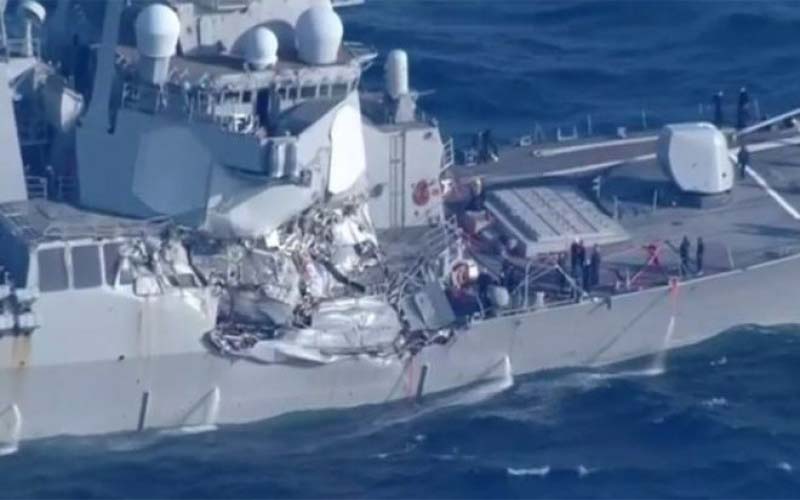Two collisions between U.S. Navy destroyers and civilian cargo ships in the Western Pacific this year were avoidable, but happened after cascades of small mistakes and missed warning signs, according to a Navy investigation.
The June collision of the destroyer Fitzgerald and the containership Crystal near Japan killed seven sailors in a flooded berthing area, and left the captain trapped on the side of the warship in his smashed cabin. Two months later, the guided missile destroyer John S. McCain collided with tanker Alnic MC near Singapore, with 10 American sailors dead.
"Both of these accidents were preventable and the respective investigations found multiple failures by watch standers that contributed to the incidents," said Chief of Naval Operations Adm. John Richardson when the reports were publicly released Wednesday. "We must do better."
As a consequence the Navy relieved and retired senior officers from the Pacific fleet, began changes to training and seamanship standards for avoiding collisions, and opened to using active Automatic identification System (AIS) signals in crowded shipping lanes.
Members of Congress like Sen. John McCain, R-Az., chairman of the Armed Services Committee, whose father is remembered in the name of one stricken destroyer, have blamed poor training and breakneck operational demands on the Navy. Much of the blame goes back to budget sequestration, the fiscal deals struck between Congress and the Obama administration to reduce the deficit, McCain has said.
The seemingly bizarre circumstances of the collisions, occurring in good visibility and sea conditions, sparked wide speculation and even some theories of sabotage in the maritime community. But the findings of Navy investigators pointed to basic mistakes and shortcomings that snowballed into emergencies – in the case of this Fitzgerald bridge watch, failing to manage contacts and collision danger. The McCain crew likewise failed to follow procedure, compounded by poor training and understanding of the ship control console, the reports say.
“The collision between Fitzgerald and Crystal was avoidable and resulted from an accumulation of smaller errors over time, ultimately resulting in a lack of adherence to sound navigational practices,” the report states. “Specifically, Fitzgerald's watch teams disregarded established norms of basic contact management and, more importantly, leadership failed to adhere to well-established protocols put in place to prevent collisions. In addition, the ship's triad was absent during an evolution where their experience, guidance and example would have greatly benefited the ship.
“The collision between John S. McCain and Alnic MC was also avoidable and resulted primarily from complacency, over-confidence and lack of procedural compliance. A major contributing factor to the collision was sub-standard level of knowledge regarding the operation of the ship control console. In particular, McCain's commanding officer disregarded recommendations from his executive officer, navigator and senior watch officer to set sea and anchor watch teams in a timely fashion to ensure the safe and effective operation of the ship. With regard to procedures, no one on the Bridge watch team, to include the commanding officer and executive officer, were properly trained on how to correctly operate the ship control console during a steering casualty.”
On the Fitzgerald, the officer of the deck and assistant discussed their position relative to the Crystal several minutes before the collision, and whether they needed to take action.
“Initially, the Officer of the Deck intended to take no action, mistaking Crystal to be another of the two vessels with a greater closest point of approach. Eventually, the Officer of the Deck realized that Fitzgerald was on a collision course with Crystal, but this recognition was too late.”
The officer failed to try contacting the containership on bridge-to-bridge radio, and the civilian crew also took no action until it was too late. The Fitzgerald’s captain should have been called to the bridge “as appropriate and prescribed by Navy procedures” early on in the situation, and the report faults other on the bridge watch and in the ship’s tactical information center for not giving the officer of the deck more input and information.
On the McCain, trouble began when the commanding officer noticed the helmsman was having difficulty maintaining course while also adjusting the throttles for speed control. He directed the watch team to divide the duties of steering and throttles with another watchstander at the control console.
“This unplanned shift caused confusion in the watch team, and inadvertently led to steering control transferring to the Lee Helm Station without the knowledge of the watch team,” the report states. “The CO had only ordered speed control shifted. Because he did not know that steering had been transferred to the Lee Helm, the Helmsman perceived a loss of steering.”
The steering was never physically lost, but the shift to a different control station was not recognized by the watchstanders. “Complicating this, the steering control transfer to the Lee Helm caused the rudder to go amidships (centerline). Since the Helmsman had been steering 1-4 degrees of right rudder to maintain course before the transfer, the amidships rudder deviated the ship’s course to the left.”
Meanwhile the commanding officer slowed the ship to 10 knots and eventually to 5 knots, but the Lee Helmsman reduced only the speed of the port shaft as the throttles were not coupled together (ganged). The starboard shaft continued at 20 knots for another 68 seconds before the Lee Helmsman reduced its speed.”
That resulted in an un-commanded turn to the left (port) into the heavily congested traffic area and close to the Alnic. In about three minutes of confusion, the bridge watch regained positive steering control at another control station, known as Aft Steering, and the Lee Helm gained control of both throttles for speed and corrected the mismatch between the port and starboard shafts.
But it was too late to prevent a collision. As in the Fitzgerald accident, the destroyer and tanker crews failed to make bridge-to-bridge radio contact, nor did they attempt the traditional last-ditch warning: five short blasts of whistle required by the International Rules of the Nautical Road.




